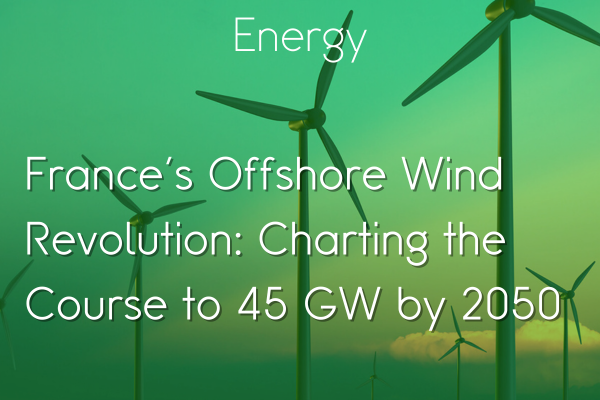France's Offshore Wind Revolution: Charting the Course to 45 GW by 2050
28 Oct, 20242minsFrance's Offshore Wind Revolution: Charting the Course to 45 GW by 2050The gentle whirr ...

France's Offshore Wind Revolution: Charting the Course to 45 GW by 2050
The gentle whirr of wind turbines off France's coastline is set to become an increasingly familiar sound as the nation embarks on one of Europe's most ambitious offshore wind programmes. While France may have been relatively late to the offshore wind party, its recently enhanced roadmap demonstrates not just commitment but growing ambition, with targets now raised from 40 GW to an impressive 45 GW by 2050.
Setting the Scene
The successful commissioning of France's first commercial-scale offshore wind farm at Saint-Nazaire in 2022 marked a watershed moment for the country's renewable energy ambitions. Now, with Fécamp operational as its second wind farm and several more under construction, France is rapidly gaining momentum in its offshore transformation.
Recent Developments and Accelerated Ambitions
The evolution of France's offshore wind strategy shows a nation increasingly confident in its renewable energy future. The government has backed its enhanced 45 GW target with concrete actions:
• Launch of two immediate auction rounds totalling 2.7 GW for summer 2024
• Preparation of an additional 8-10 GW auction round
• Successful completion of the world's first commercial-scale floating wind auction
• Introduction of crucial simplification measures
Recognising that bureaucracy could throttle progress, the government has committed to halving project timelines from 12 to 6 years - a game-changing development for the sector.
The Scale of Ambition
To put these enhanced targets in perspective, 45 GW represents enough power to meet roughly 25% of France's electricity needs. This ambitious goal requires:
• Installation of thousands of turbines
• Creation of over 20,000 direct and indirect jobs
• Development of major port infrastructure
• Significant grid reinforcement
But numbers alone don't tell the whole story. This is about establishing an entirely new industry for France, one that promises to revolutionise its coastal economies while helping to meet climate commitments.
A Tale of Two Technologies
France's offshore wind strategy is particularly interesting because it embraces both fixed-bottom and floating wind technologies. The country's varied coastline, with its differing water depths and seabed conditions, makes this dual approach not just desirable but essential.
Along the Atlantic and Channel coasts, traditional fixed-bottom turbines will predominate in shallower waters. Meanwhile, the deep waters of the Mediterranean will become home to floating wind farms, positioning France as a pioneer in this emerging technology.
Regional Renaissance
The impact of this ambitious programme will be felt far beyond the energy sector. Coastal regions are already seeing the benefits of offshore wind development:
Atlantic Coast
The transformation of Saint-Nazaire from traditional shipbuilding port to offshore wind hub offers a glimpse of the future. Local factories are retooling to produce turbine components, while training centres prepare the next generation of offshore wind technicians.
Mediterranean Coast
Plans for floating wind farms are breathing new life into ports like Marseille and Fos-sur-Mer. These cities are positioning themselves as centres of excellence for floating wind technology, with potential to export their expertise globally.
Environmental Stewardship
France's approach to offshore wind development places environmental protection at its heart. Rather than viewing environmental concerns as obstacles, the roadmap incorporates them as fundamental design principles. This includes:
• Extensive marine ecosystem monitoring
• Collaboration with fishing communities
• Protection of bird migration routes
• Innovation in noise reduction technologies
The Supply Chain Challenge
One of the most ambitious aspects of France's roadmap is its commitment to developing a domestic supply chain. This isn't just about building wind farms; it's about creating a sustainable industry that can compete globally.
Key focus areas include:
• Manufacturing facilities for major components
• Port infrastructure development
• Installation and maintenance vessels
• Training and skills development
Looking Ahead
The path to 45 GW won't be without its challenges. Grid integration, supply chain development, and stakeholder engagement will all require careful management. However, France's structured approach, with clear milestones and regular review points, provides a robust framework for success.
France's offshore wind roadmap represents more than just an energy strategy - it's a vision for transforming the country's coastal regions while addressing the climate crisis. The combination of clear targets, technological innovation, and community engagement suggests that France is well-positioned to become a major player in the offshore wind sector.
As the white turbines multiply along France's coastlines, they'll stand as symbols of the country's commitment to renewable energy and sustainable development. The journey to 45 GW by 2050 is ambitious, but with strong policy support and growing industry momentum, it's a goal that increasingly looks within reach.
The success of this programme will not only contribute to France's energy transition but could also establish the country as a global leader in offshore wind technology, particularly in the promising field of floating wind. As one industry expert recently noted, "France may have started late, but it's making up for lost time with a clarity of purpose that many other nations would do well to emulate."


